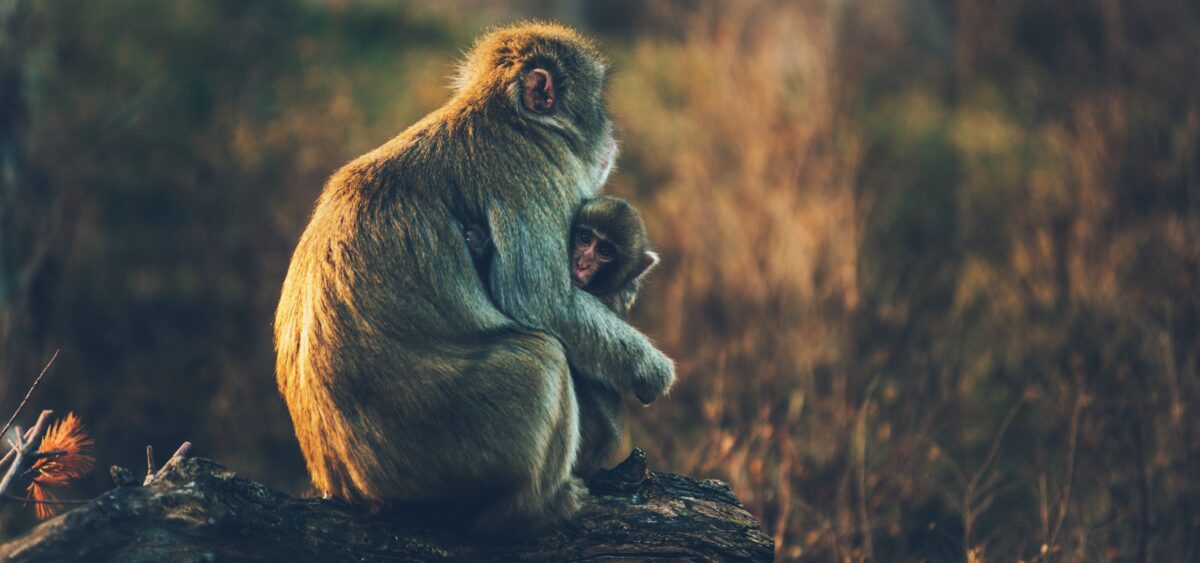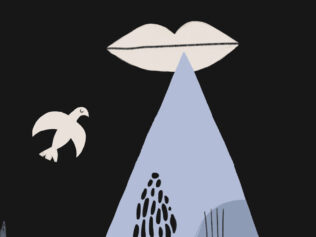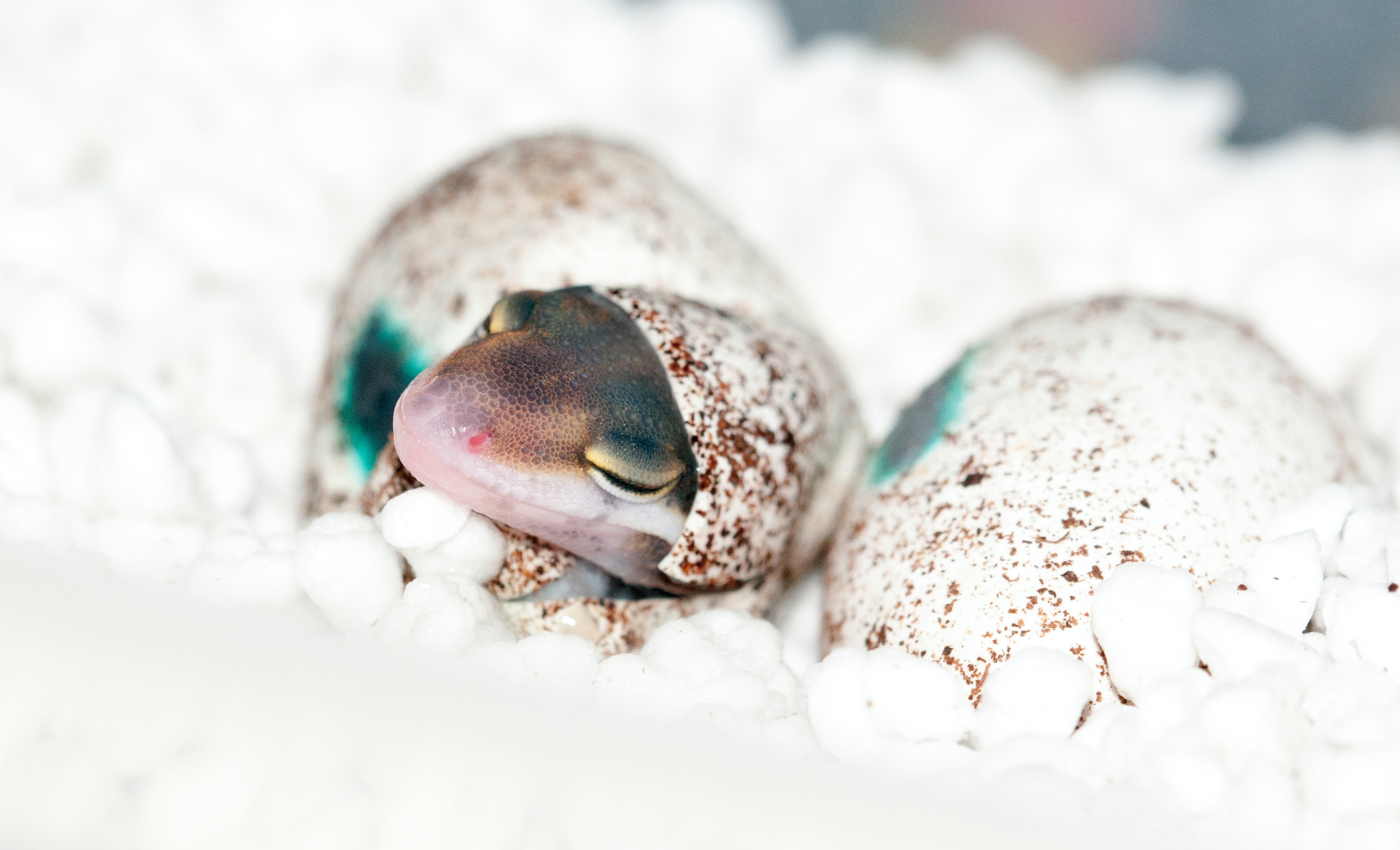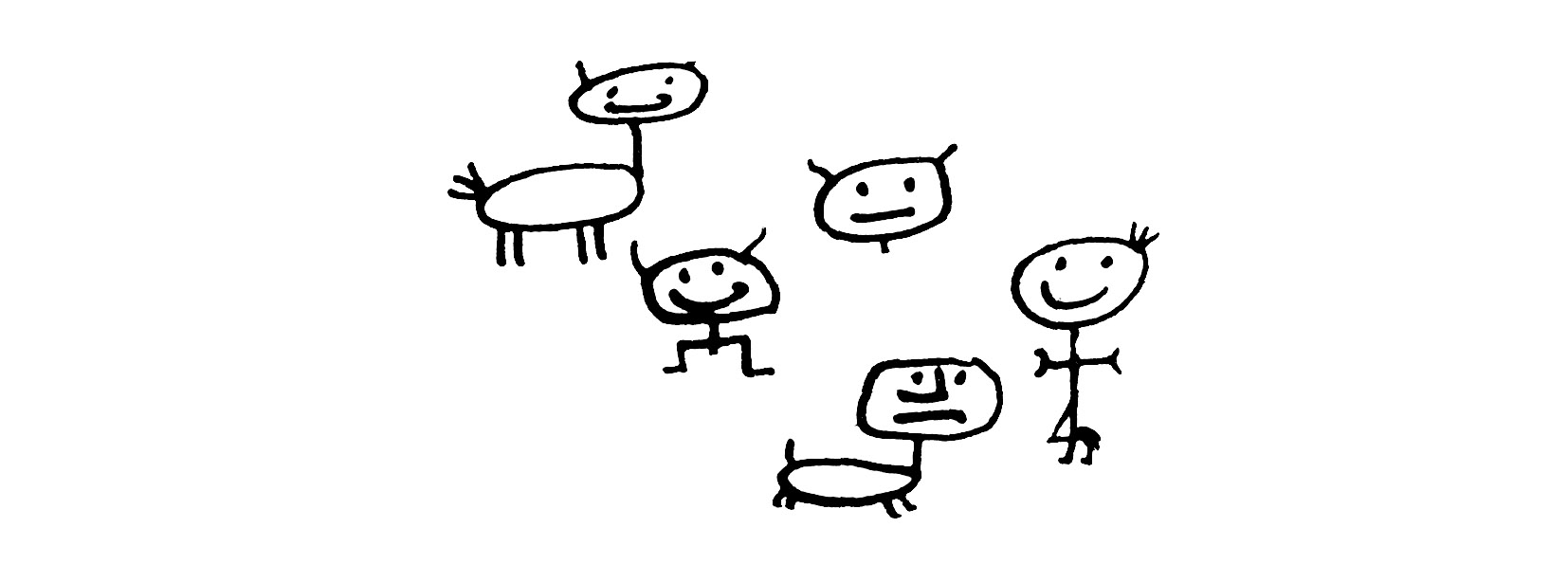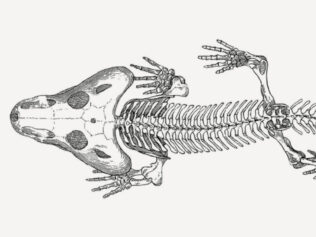
What do animals get from their parents? Some get food, others get skills and knowledge, and others still get emotional support: adult male chimpanzees look for consolation in mum’s arms when they are stressed.
A few years ago, I had the honour of observing a female polar bear with two cubs. The mother was waiting patiently by a seal’s breathing hole for someone fat and tasty to emerge. Earlier, however, she had led the kids 30 metres away and explained something to them: the playful little ones lay quietly and calmly in a snow hollow. Unfortunately, I was too far away to hear what she said, but I’m sure I’m not the only one who would give a lot to learn that powerful spell.
Spidermum
For most animal species any parental care – if it exists at all – usually ends soon after the young are born. There are, of course, extreme exceptions, which I have already described in “Przekrój” – such as the spider mother digesting her own tissues so that baby spiders can suck them up for their first breakfast. But in the case of most invertebrates, the female lays eggs in as safe a place as possible, or – like many wolf spiders – carries a cocoon full of eggs and then gives her young a ride on her back, although they soon sprawl around the area and must manage on their own. There are so many of them that at least a few will survive, so the evolutionary goal, which is to pass genetic material to the next generation, is achieved. A typical start of an independent life looks similar in fish, amphibians and reptiles, and even in such animal intellectuals as cephalopods. Although the mothers of squid and octopuses (and many more of their class) take heroic care of eggs, defending them and providing them with oxygen, they die as soon as the young hatch, so they can’t teach them anything.
Things are a bit better among birds and mammals, where usually at least one parent takes care of the children until they reach adulthood. But this isn’t always the case. Take my favourite species, southern elephant seals: mothers feed their pups for just three weeks, only to leave the milk-swollen babies on the beach and return to the ocean. They can’t really be blamed, because in that time the nursling would have tripled its weight (from 30 to 50 kilograms after being born, to almost 150 kilograms), while the mother would have lost almost 200 kilograms, one-third of hers. As you observe these females of the world’s largest seals, you can clearly see how they shrink daily during feeding time, while their children swell up. After three weeks of this, the young are sometimes so full they can’t move, and they need to quickly transform that caloric bomb into muscle, bone and blubber. This takes them a few more weeks; it’s only when they get hungry that they start their encounter with delicious squid, predatory killer whales and violently calving icebergs. It’s no wonder that only one-sixth of the pups makes it through their first year – the ones that learn how to find food and avoid danger quickly and efficiently.
Naturally, this is assuming that they even survived until weaning in the first place – 10% of them die earlier, crushed by the enormous males during their fight to establish and sustain dominance on the beach. The males pay them practically no mind, because the babies they’re smearing into the ground usually aren’t their offspring. They are from the previous season, so most probably descendants of the former ruler of the territory. For the huge elephant seals, breeding season is so taxing that once it’s finished they frequently die of exhaustion, and there’s little chance that they’ll recuperate in a year and dominate the beach again. Imagine it yourselves: these animals’ harems can contain up to a hundred females that other males need to be constantly chased away from. There is no time to eat. When I listen to The Exploited’s “Sex and Violence”, I think about male elephant seals and their glorious death of both the fighter and the lover.
Baby elephant seals are not the only ones plagued by high mortality, although things really are harder for them than for most mammals or birds. In species that do not congregate into permanent social groups, the young also usually encounter the world on their own, but at least they leave the more or less metaphorical nest when they are almost fully grown. This is a good place for a reminder that, especially in the spring, one can often encounter obviously young and seemingly abandoned animals. Most frequently those are fledglings: almost fully-fledged chicks that have literally outgrown the nest and now live sometimes in trees, sometimes in bushes, unable to fly very well. Their parents still take care of them, which is why we can’t adopt them in a naive impulse of pity. At most, if a small numpty like that is sitting somewhere on the pavement – or, even worse, on the road – you should move it somewhere safer nearby. Then walk away and check whether the parents arrive – usually they’ll appear very soon.
The same goes for cute little bunnies or fawns. You might encounter them during a walk, but then you should walk away as quickly as possible: their mum has left them in the grass to get her fill of food in peace, while at the same time avoiding the attention of their many predators. Let’s not steal kids from their parents.
Autodidacts and hobby clubs
However, when the young really do start to make their own way in life, they still have much learning to do, and it can take many turns for the worse. Birds must learn how to fly properly; this is well illustrated by one of my favourite photos, which shows a group of juvenile Laysan albatrosses standing on a beach. Their beaks are turned against the wind; stretching their wings wide, they’re trying to figure out how to angle them in order to catch the breeze and fly away. This is exactly how sailors learn to set their sails correctly, so that they can go where they want, and not where the elements take them. It sometimes takes many years for large birds to learn life and it will be almost a decade before albatrosses even think about starting their own families. They mate for their whole lives, which last a few dozen years.
While emperor penguins don’t need to learn to fly, they also spend the first two or three years of their lives sightseeing across the Antarctic – just like the many representatives of our species who wander the world for a while before they finally settle somewhere. Penguins also need to learn how to take care of themselves first, before they get around to reproduction and rearing their young. I have seen these roaming emperor penguins a few times – already fully grown, but not yet in their mature colouration – and these were the only occasions when I could admire these animals in the wild, because I haven’t been able to reach any emperor penguin colony so far.
But, as is frequently the case when it comes to cognitive skills, ravens provide my favourite example. A little over 10 years ago, it turned out that whenever these juvenile birds have the opportunity, they play a very risky game. When they chance upon a sleeping predator – a lynx, a coyote, a wolf or a bear – they sneak up on it and… tug its tail! Of course, the ones that have been brutally woken up aren’t thrilled, so they lunge towards the aggressors to teach them a lesson. But this is exactly what the birds expect, and they escape at the last moment (or not, but there’s no retaking this test if you fail it, so it pays to be focused). Initially, it was hard to establish the meaning of the dangerous game these adolescents played, until it turned out that it was their way of… conducting research! They learn the speed and range of their future tablemates’ reactions, so that later – when they share carrion – they can focus on eating, and not wonder whether that lynx on the other side of the deer carcass isn’t planning to lunge at them. What’s even more interesting is that a special kind of inter-animal bond frequently emerges as a result of these games, at least with wolves. The raven and the wolf establish a personalized partnership, and later react to each other and learn each other’s signals. If the raven finds carrion or a wounded animal somewhere, it will call its friendly wolf, who – once it hunts down the victim or bites into the carrion’s skin – allows the bird to safely eat its fill.
Turning over a new leaf
The above-mentioned female polar bear spends almost three years with her cubs. In that time, they gradually become stronger, more capable and experienced under her tutelage, and finally reluctantly become independent when their mother’s next oestrus attracts a potentially dangerous male. By observing their mother, cubs learn how to locate and capture prey, little by little gaining the right qualifications for being a mature, self-reliant polar bear.
In the case of other animals, for example orangutans, it takes even longer. For the first two years, the infant almost constantly hangs off its mother. Once it starts to move about on its own, it remains under her care, being breastfed until it’s eight years old, and the deep bond remains in place later in life. Adult offspring visit their mother even 15 years after being weaned.
We have also recently found out that in our other relatives – chimpanzees – the mother-child bond similarly persists long into the latter’s adulthood. Unlike orangutans, chimpanzees are social, so they keep in touch with their family. But it turns out that even completely mature males look for consolation in their mothers’ arms – especially when they get a hiding from more dominant individuals.
Male killer whales do not even pretend to be independent. They spend their whole lives in pods led by their grandma, aunt or mum, leaving them behind only to copulate with someone from a neighbouring pod, more genetically distant. As a matter of fact, we’ve discovered that killer whales undergo menopause, and have proven the gigantic evolutionary significance of grandmas: for the last few decades of their life (which can last for over 100 years) they no longer reproduce, but their assistance, wisdom and experience determine the reproductive success of their female descendants. Interestingly, menopause has not been observed among elephants, whose society is similarly organized.

A long-lasting bond – usually with the mother – is undoubtedly advantageous to the young’s education, especially that it is most frequent in species known for their intelligence. We’ve recently learned that a long-term bond with the father is common in most human societies, but unique in comparison with other mammals. I can only hope that the one which connects me and my daughter will always be good.
Animal pedagogy
Tim Caro is an animal behaviour specialist. For many years, he studied cheetahs in Tanzania. He observed cheetah mothers bringing their children dead prey, most often young or adult gazelles. The older the children were, the more likely it was for the prey to still be alive, although just barely at the start. Later, as the baby cheetahs became stronger and more practised, the condition of the animals they were provided with improved, until they received almost unwounded, adult individuals.
Is this purposeful, conscious teaching? In 1992, Caro – along with another famous researcher, Mark Hauser – formulated three fundamental criteria for evaluating this. First, for something to be considered true teaching, the student’s skills must improve as its result. Second, it’s important that the teachers behave in a specific way in the presence of the student; third, teaching should involve potential costs for teachers and it can’t have any immediate benefit. Interestingly, Caro himself wasn’t able to prove whether the female cheetahs really were teaching their cubs according to these rules, because he couldn’t prove that the youngsters’ skills were improving as a result…
There were more and more examples of specific animal behaviour, but none fulfilled all the required criteria, or at least it was impossible to prove that it did. It was a known fact that apart from cheetahs, our domestic cats also bring barely-alive mice for their children to kill. It seems that sea otters teach their offspring to break shells against a stone held on the stomach while the animal floats on its back. Elephant mums teach babies how to handle their own trunks – initially they just wave them around or even trip on them, but with time they become more skilled at manipulating objects, feeding themselves and drawing drinking water (no, elephants don’t drink through their trunks, but they can scoop up water with them). Sperm whales and various dolphin species learn dialects specific to their family groups. But the key question is: do they learn or are they taught? True, it’s hard to differentiate the two. Was I the one who taught my daughter to say ‘hello’ or did she learn it herself, hearing how I greet her? In our case, it was certainly a mix of these two processes – but people can always be asked for more detail. That’s a bit harder with other animals.
In 2000, Lisa Rapaport was studying golden marmosets – tiny monkeys from South America. A female put her hand into a hollow in a broken branch, looking for something to eat. However, she didn’t take anything out, but called her seven-month-old child and made sounds that signified normal feeding. This time, however, the baby didn’t get anything; his mum moved away from the hole, he reached down himself and pulled out a delicious frog! This example looked very promising; unfortunately, there were too few observations like this to prove anything.
A breakthrough came in 2006, although the previous three criteria had been joined by a fourth, an assessment: the teacher must evaluate the students’ progress. To the surprise of everyone and the outrage of some, the first absolutely unambiguous example of teaching others didn’t come from any of our favourite animal intellectuals, but from ants! Specifically, from a European species called Leptothorax albipennis.
Unlike many other species, these ants don’t leave a pheromone path from the nest to their prey, but memorize the route and then teach it to another individual during a so-called tandem run. A teacher running with a pupil stops and shows her vertical landmarks (i.e. she changes her behaviour), so getting to the food takes her much longer (there’s a cost to it). After this exercise, the pupil can not only reach the target herself, but is also able to teach others (her skills have increased). The example is perfect: when the two stop at a landmark and the pupil has committed it to memory, she lets her teacher know by tapping her abdomen with her feelers. They won’t carry on until that happens (the assessment). The system is flawless, although this method of taking exams might not be appropriate for humans.
Another example emerged at the same time: meerkats bring their young scorpions that have been rendered harmless to some degree – at first dead ones, then live ones with the sting bitten off, then almost intact ones – and spend a lot of time teaching the children how to handle them safely. Interestingly, it turned out that the adults don’t really evaluate their students’ knowledge, but are guided by their age, and react to the youngsters’ signals. How was this verified? When adults were played sounds made by older children, they brought potentially dangerous scorpions to babies, and when they heard recordings of very small pups, they brought dead, stingless prey to reasonably mature youngsters.
Birds have also joined the species that have ‘beaks’. Superb fairywrens teach their chicks a special sound: they get food only after they’ve uttered it. Southern pied-babblers, on the contrary, patiently teach their young which sound made by the adult means feeding, and when they can announce their presence. At all other times they’re supposed to be quiet, so that they’re not eaten themselves. However, the cheeky babies learn to cheat and they make a racket to get as much food as possible when they’re on the ground – especially vulnerable to a predator attack. To protect them, the parents double their efforts, just so that the chicks remain unnoticed.
Furthermore, various species of dolphin indicate prey with their snouts or let go of barely-alive fish, so that their young learn to hunt. These exercises with an apprentice last even eight times as long as individual hunts. The largest dolphins – killer whales – not only do the same thing with the sea lions they catch, but also patiently impart to their young the methods for safely emerging onto the beach for pinniped cubs or washing seals off ice floes in a coordinated way. Female wolves display excessive fear around snares to show children that they’re dangerous. Does do the same thing when they catch a human’s scent or see someone. A vixen will patiently teach her cub how to pull earthworms from the soil – strongly enough, but so gently that they don’t break.
As you can imagine, our close relatives have also already invented school: female chimpanzees teach their young to crack nuts on a stone anvil, carefully demonstrating how to hold a hammer made from a branch. And crab-eating macaques in Thailand show their offspring how to floss with human hair! I don’t know whether our children would be in any way consoled by this, but now – shortly after the start of the school year – it’s back to school also for kids of other species, who never even had their holidays. They are getting on with it, and nobody complains – like in the old days.
Translated from the Polish by Marta Dziurosz


